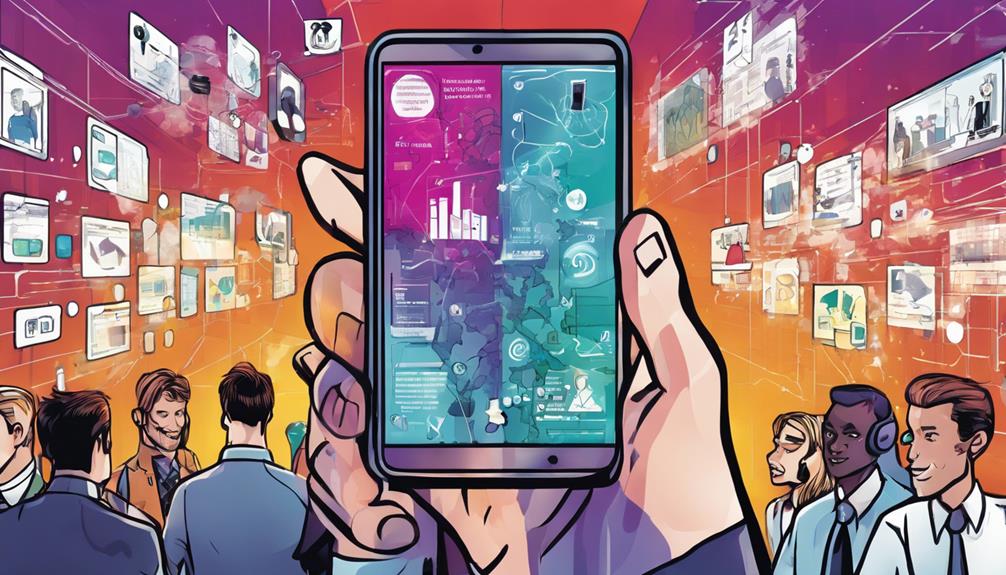Mobile apps can access your business success by boosting customer engagement and streamlining your operations. With features like push notifications, you can keep your brand top-of-mind while offering app-exclusive deals that encourage frequent visits. They simplify sharing essential information, enhancing customer loyalty through personalized experiences. Plus, apps provide quick access to your offerings, making it easier for customers to connect. By leveraging these tools, you'll not only increase your brand visibility but also enhance efficiency within your team. Ready to elevate your business strategy? There's so much more to explore on how to maximize your app's potential.
Key Takeaways
- Mobile apps enhance brand visibility and customer engagement, creating a direct line of communication for promotions and updates.
- Personalized content and offers from mobile apps boost customer loyalty and retention through tailored interactions.
- Streamlining operations via mobile apps automates processes, improves communication, and enhances overall workflow efficiency.
- Utilizing push notifications and in-app rewards encourages repeat purchases and keeps your brand top-of-mind.
Key Advantages of Mobile Apps
Mobile apps offer businesses a powerful tool to boost brand awareness and engage customers more effectively than traditional methods. By creating a branded app, you simplify the sharing of essential business information, making it easier for customers to familiarize themselves with your services.
This familiarity strengthens emotional connections, encouraging repeat interactions. With a mobile app, you also enhance convenience, providing quicker access to your offerings than a website can. As a result, customers are more likely to engage with your brand regularly.
Plus, the app acts as a direct line to your audience, allowing you to push notifications and updates, further cementing your business's presence in their daily lives. Embracing this technology is key to thriving in today's competitive landscape.
Enhancing Customer Engagement

By leveraging app-exclusive deals and interactive features, businesses can greatly boost customer engagement and foster loyalty.
Offering discounts or rewards only available through the app encourages users to interact more frequently.
Incorporating interactive elements like polls, quizzes, or games not only captures attention but also creates enjoyable experiences that keep customers coming back.
Additionally, push notifications remind users about new deals or updates, ensuring your brand stays top-of-mind.
By simplifying the feedback process, you can gather valuable insights directly from your customers, showing them their opinions matter.
Ultimately, a well-designed app enhances convenience and strengthens the relationship between your business and its customers, leading to increased engagement and long-term loyalty.
Personalization for Business Growth

Enhancing customer engagement through interactive features sets the stage for deeper personalization, allowing businesses to tailor their services to meet individual preferences and needs.
By leveraging mobile apps, you can gather valuable data on user behavior, helping you understand what your customers truly want. This insight enables you to deliver customized content, offers, and notifications that resonate with them.
Implementing quizzes or preference surveys can further refine your approach, ensuring that each interaction feels personal and relevant. As a result, you'll boost customer loyalty and retention rates.
Streamlining Operations and Efficiency

Streamlining operations and efficiency through mobile apps can greatly reduce the time it takes to complete tasks and improve overall productivity. By automating routine processes and providing instant access to essential tools, you can focus more on strategic initiatives.
| Benefit | Impact |
|---|---|
| Faster Task Completion | Reduces time spent on tasks |
| Improved Communication | Enhances teamwork and clarity |
| Data Accessibility | Enables informed decision-making |
With mobile apps, you can manage inventory, schedule meetings, and track project progress all in one place. This not only cuts down on manual work but also minimizes errors, leading to a smoother workflow. Embrace mobile technology to transform how your business operates.
Boosting Brand Visibility

Mobile apps can greatly elevate your brand visibility, allowing customers to easily access and engage with your services anytime, anywhere.
By having a dedicated app, you create a direct channel for communication, making it simpler for users to find information about your offerings.
Additionally, branded apps encourage sharing, expanding your reach as customers promote your business to their networks.
You'll foster familiarity and trust with your audience through consistent interactions, enhancing emotional connections.
App-exclusive features or promotions can capture attention and drive repeat visits, ensuring your brand stays top-of-mind.
Ultimately, a well-designed mobile app serves as a powerful tool in amplifying your brand's presence and making it more recognizable in a competitive marketplace.
Leveraging Marketing Opportunities

Taking advantage of marketing opportunities through a dedicated app can greatly boost your business's outreach and engagement with customers. You can effectively leverage these opportunities by focusing on the following strategies:
- Push Notifications: Utilize targeted notifications to inform users about promotions and new products, keeping your brand top of mind.
- Loyalty Programs: Implement in-app loyalty rewards to encourage repeat purchases and enhance customer retention.
- Social Sharing: Enable social media sharing features to amplify your marketing reach and attract new customers through word-of-mouth.
- User-Generated Content: Encourage users to share their experiences and reviews within the app, creating authentic content that boosts credibility.
Insights From Young Entrepreneurs

Young entrepreneurs are redefining success by blending innovation with ambition, proving that age is no barrier to achieving remarkable wealth and influence.
You'll find that figures like Austin Russell, who became a self-made billionaire at just 25, showcase the potential of youth in entrepreneurship. These trailblazers inspire you to pursue bold ideas and embrace technology as a key driver for growth.
They emphasize the importance of practical experience over traditional education, encouraging you to learn by doing. As you navigate your entrepreneurial journey, consider how agility and creativity can lead to unique solutions.
Engaging with mobile apps can further enhance your business strategy, helping you connect with customers and adapt to market demands effectively. By utilizing mobile apps, businesses can streamline their operations and interact with customers in a more efficient manner. Additionally, mobile apps can also be integrated with various business cost reduction strategies, such as automating certain processes and reducing the need for physical infrastructure. This can ultimately lead to increased savings and improved financial performance for the business.
Future Trends in Mobile Applications

Innovative technologies are shaping the future of applications, promising to enhance user experiences and streamline business operations. As you look ahead, consider these key trends that will redefine mobile apps:
- AI Integration: Expect smarter apps that personalize user experiences based on behavior and preferences.
- 5G Connectivity: Faster internet speeds will enable seamless streaming and real-time interactions for enhanced functionality.
- Augmented Reality (AR): AR will transform how customers engage with products, offering immersive experiences that drive sales.
- Cross-Platform Development: Apps that work effortlessly across devices will dominate, improving accessibility and user satisfaction.
Conclusion
In today's digital age, investing in mobile apps isn't just smart; it's essential for your business.
By harnessing their power, you'll not only enhance customer engagement and streamline operations, but you'll also boost your brand's visibility in a crowded marketplace.
As you embrace these innovative tools, remember that the future of business is already here—don't get left behind like a rotary phone in a smartphone world.
Unleash your potential and watch your success soar!









